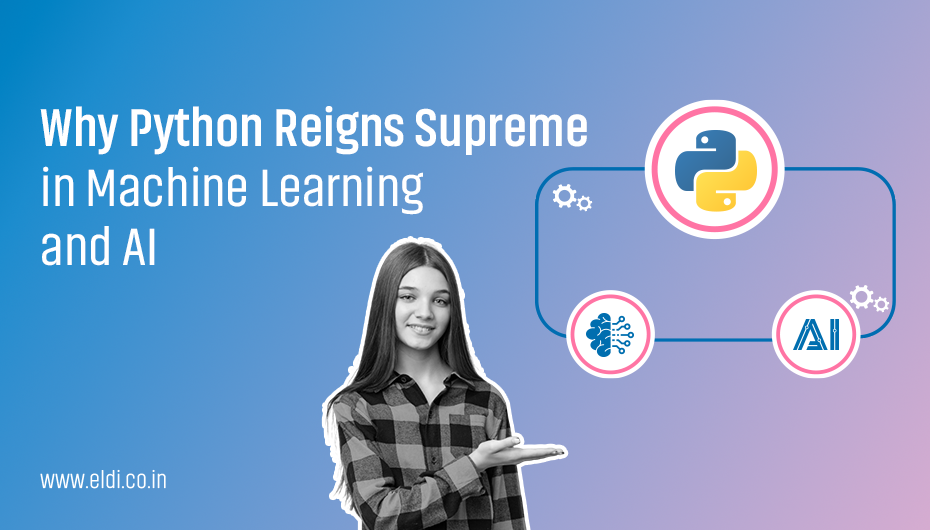Why a Python and Machine Learning Course in Ahmedabad is Perfect for Freshers
Python is one of the best and, simultaneously, one of the most modern programming languages that drive unique innovations globally. Python has become desirable for starters, college students, or graduates, as it allows them to groom themselves in the market and have the upper hand over others in the IT fraternity.
In this article, we will discuss some reasons for Python’s continued popularity in the programming world, the various benefits of enrolling in a Python Development Training Course in Ahmedabad, and how you can leverage the same knowledge for a successful career in the upcoming 2025.
The Popularity of Python
Python has always been listed among the top programming languages worldwide. Its easy syntax, great libraries, and multidimensional technology support have made it a favorite of developers, researchers, and businesses.
Whether you’re developing websites, conducting big data analysis, or building AI applications, Python offers endless opportunities.
Why Ahmedabad?
Ahmedabad, a rapidly growing and developed hub in Gujarat, is turning out to be a hotspot of technology and innovation. With more startups, IT companies, and training institutes popping up, Ahmedabad presents the perfect planned way for freshers to learn and apply their Pythonic skills properly. A Python course in Ahmedabad is not merely theoretical training; it’s access to the real world.
Why Learn Python in 2025?
1. High Demand in an Industry
Implementation fields for Python include, but are not limited to:
- Web Development: Very simplified website design using Frameworks like Djongo and Flask.
- Data Science and Analytics: Pandas and NumPy are handy in processing large datasets.
- Artificial Intelligence and ML: Libraries like Tensorflow, Keras, and Pytorch stimulate cutting-edge content.
- Automation: Python scripts help accomplish repetitive tasks efficiently.
This versatility is a godsend in emerging technology; thus, knowledge gained from a Python programming course will surely turn the tables in 2025.
2. Booming Career Opportunities
Positions like Python Developer, Data Scientist, and Machine Learning Engineer are best suited. Not only experienced programmers but also freshers from the Python Development Training course get a good pay package while working with Python.
3. Beginner-Friendly
Thanks to simple syntax and readability, Python is ideal for first-time programmers. Concepts are easy to grasp, giving Python for Beginners the time to concentrate on problem-solving and not the finer technical points of the language.
The Advantages of Taking a Python Development Training Course in Ahmedabad
For aspiring Python developers, studying in Ahmedabad offers the following unique advantages: why attending a Python & Machine Learning Course locally would enhance their career prospects:
1. Practical Learning
Training institutes in Ahmedabad focus on hands-on learning. You will make yourself aware of real-time projects to gain practical skills. This goes a long way in connecting various theoretical aspects with industry requirements.
2. Networking with the Industry
Many of the local IT training institutes in Ahmedabad have linked up with various technocrats, startups, and industry specialists. They pave the way toward:
- Internships: These allow for gaining experience while learning.
- Placement: Many institutes provide placement assistance to help you get your first job.
3. Cost-effective Training
All Advanced Python Programming courses offered in Ahmedabad are cheaper than those offered in metropolitan centres and are equally professional and of good quality.
4. Merging with Machine Learning
Many Python training academies in Ahmedabad offer advanced modules such as Python & Machine Learning Course. This gives their students a little extra edge in the fields of AI and data science.
What You Will Learn at a Python Development Training Course?
1. Complete Curriculum
A good Python programming course offers a rounded curriculum that will take learners from basics to advanced applications.
- Basic Python Syntax: The course introduces some core programming concepts to teach students how to write clean, readable, and efficient code.
- Libraries and Frameworks: Participants master widely used tools like Django for web development, Flask for building lightweight applications, and Pandas for data analysis and manipulation.
- Projects and Assignments: Real-world challenges provide hands-on experience for learners in the course. The projects strengthen problem-solving skills, enabling students to merge the projects into applications worthy of a portfolio.
Advanced Modules
The advanced Programming Classes in Ahmedabad are meant for those students who aspire for deeper specialization:
- Python & Machine Learning: This module follows an introduction to machine learning concepts, and therefore, participants will be able to build predictive models and analyze complex datasets.
- Advanced Python Programming: This course prepares students to perform advanced coding tasks across many platforms by teaching them object-oriented programming, file handling, error management, and multithreading.
Career Development Support
Recognizing the importance of employment, numerous IT Training Institutes in Ahmedabad provide career-oriented support such as:
- Resume Building: The courses teach students to build a career that keeps all presentable skills and projects intact.
- Mock Interviews: Practice sessions prepare students for confidence-building and polishing their communication skills for technical interviews.
- Portfolio Development: By the end of the course, learners will have a project portfolio they can present to potential employers, which will significantly enhance their job prospects.
This holistic approach ensures that learners are on the right path toward mastering Python and other tools and supports their advancement in their respective careers.
How to Select the Best Python Programming Course in Ahmedabad?
Choosing the right Python programming course can make all the difference in a student’s career and learning experience. Here are a few crucial pointers one should take note of while choosing:
1. Faculty Expertise
A great Python Developer Course becomes all the more interesting because of the quality of the instructor. One must look for those borrowed people from the industry who have good experience as developers, both from theoretical and practical aspects. Experienced developers can highlight the significance of certain aspects of commerce, provide valuable insights, and give you real-world examples and guidance that assist you in considering current market trends.
2. Complete Curriculum
An ideal Python course covers the basics and advanced concepts. Basic concepts include syntax, data types, and control structures. Some courses have very advanced modules in machine learning, data analysis, and web frameworks like Django or Flask. A hands-on approach helps students achieve practical skills that make them job-ready.
3. Reviews and Testimonials
Student feedback is another excellent way of determining if an institute’s quality matches your expectations. It would help to check for any online reviews, testimonials, or ratings left by former students to judge the effectiveness of the course, the quality of teaching, and the overall satisfaction quotient.
4. Placement Support
Choosing an IT course that offers adequate placement assistance is a good idea. Schools that can connect you to hiring companies, workshops on building a resume, mock interviews, and career counseling could enhance your job prospects manifold upon course completion.
5. Flexibility
For both students and working persons, flexibility is the lifeblood of any business, and many programming classes in Ahmedabad conduct weekend and evening batches to spare time for other engagements. Select a schedule that suits your availability to keep the momentum going.
FAQs
1. How long does a training course in Python development last?
Most courses are two to six months long, depending on the level of expertise and modules included.
2. What skills will I gain after completing the course?
You will learn Python syntax, fundamental data analysis, basics of machine learning, and web development. Along with these, you will acquire skills in problem-solving and project management.
3. Why take such a course in Ahmedabad?
Ahmedabad provides good quality yet affordable training with local industry connections, making it an ideal location for freshers.
4. What career options are open to me after the course?
The options include that of a Python developer, data analyst, machine learning engineer, and web developer.
Your Gateway Towards a Bright Future!
The mere essence of learning Python is a skill and a ladder to a blissful IT career. When one considers enrolling for a Python Development Training Course in Ahmedabad, they are not merely learning a programming language; they are building a platform to garner innovation, growth, and success in the future.
The IT training institutes in Ahmedabad provide a perfect blend of practical learning, affordability, and career support. Whether you are a college student, fresher, or graduate, a Python programming course that meets any of these requirements will assist you in reaching your professional goals.
So what really are you waiting for? Take a step to become a Python expert and pave the way to many more opportunities in the tech industry. Start your journey in Python today and watch your career lift off.


